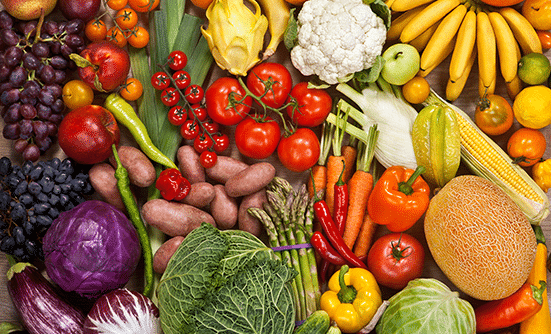
Fruits, veggies, beans, and whole grains boast efficient cancer-protective advantages due to their vitamin, mineral, and phytonutrient profile. In addition, numerous veggies and fruits include anti-oxidants, such as vitamin C and vitamin E, which lower the risk of damage to healthy cells. The American Institute for Cancer Research study encourages making plant foods the piece de resistance– 2/3 of your plate filled with veggies, whole grains, fruit, and 1/3 of the plate for lean animal protein, such as fish or chicken (1 ). Attempt to opt for 2.5 cups of non-starchy fresh, frozen, canned vegetables and fruits each day!
Emphasize plants
Focus on fiber
Standards from the American Institute for Cancer Research Study (AICR) suggest choosing 30 grams of dietary fiber every day. Entire grains, a sort of dietary fiber, have in fact been revealed to be protective versus colorectal cancer, and an analysis launched in April 2020 suggests a high fiber diet plan may likewise lower the danger of breast cancer (2 ). The advantages of dietary fiber extend beyond reducing cancer threat, fiber has actually similarly been exposed to be helpful in lessening the threat for many consistent illness, consisting of heart illness and diabetes, as remembered in a current 2020 study released in The Lancet (3 ). Dietary fiber can promote satiety, or the feeling of fulfillment after consuming, which can use wonderful benefit for weight management. Dietary fiber is discovered in fruits, veggies, entire grains (such as oatmeal, wild rice, whole-wheat bread), and beans (beans, lentils, peas).
Pick lean proteins
Standards from AICR and World Research Study Cancer Fund (WCRF) recommend restricting the intake of red meat intake to less than 18 ounces a week (this has to do with 3 parts weekly) and preventing usage of processed meats (4, 11). Processed meats consist of meats that are smoked, treated, salted.
Taste your food with herbs & & & spices
Due to the fact that various processed and packaged foods have salt, goal to taste foods with spices, herbs, citrus, or vinegar when cooking. These offer extra dietary and taste advantages without adding to day-to-day salt consumption.
Avoid the Soda and Limitation alcohols
For cancer avoidance, the present AICR/WCRF requirements recommend not consuming alcohol due to the link in between alcohol and cancer threat (6 ). If alcohols are taken in, restriction consumption to no higher than 2 drinks for males and 1 drink for females every day (4,6, 11).
Sugar-sweetened beverages, like soda, juice, and sweetened teas, are all significant sources of sugarcoated. Extreme intake of sugarcoated from sugar-sweetened beverages can increase the danger of weight gain and various persistent illness, including diabetes, liver disease, and heart problem (5 ). Stay hydrated with water, flavored water, or instilled water with fruit pieces. An excellent alternative to soda is sparkling flavored water– still carbonated, and without sugarcoated.
Select Heart-Healthy fats
Restriction consumption of fried foods and foods high in hydrogenated fat for general health after cancer treatment. Hydrogenated fats are found in fatty meats, butter, full-fat dairy, and cheese. Nuts and seeds are great sources of healthy fats, protein, fiber, vitamins, and minerals.
Food First, not supplements
Objective to satisfy your dietary requirements through food alone, unless a dietary supplement has really been especially suggested by your medical provider. Natural supplements in particular are not well studied in people, are not FDA authorized prior to launch, and might engage with the effectiveness of various medications (8 ). In addition, high dose antioxidant supplements may in truth do more damage than outstanding, as seen in the 2011 SELECT trial in which vitamin E supplements was exposed to in fact increase the threat of prostate cancer (9 ). It is best to consult your medical group prior to taking anything that is not suggested.
Ditch Trend Diets
Weight cycling can increase the risk of undesirable cardiovascular effects (10) and promote an unhealthy relationship with food. Watch out for cleanses, 30-day diet plans, weight reduction supplements, and diet strategies backed by evaluations, instead of science. Ask to talk to a Registered Dietitian Nutritional professional for assistance on making sustainable, long lasting health and dietary modifications.
Choose a Constant Meal Pattern
If 5 or more hours have in fact gone without consuming, thats the caution. When feeling starving– spend some time to consume, take in some water, take a break!
Get in touch with food
Lots of cancer treatments can affect and modify dietary intake. After treatment, spend a long time to find, take a look at, and reconnect with food in a substantial method. Food is suggested to be delighted in, and even better– happy in together with liked ones. Connect with food in the kitchen area by cooking, sharing, and check out new dishes, parts, and tastes. Go to a regional farm or farmers market to inspect out local and seasonal consuming. Take part in a nutrition workshop and find how food can play an essential function in health and wellness. Limitation taking in on-the-go, and take pleasure in meals at-the-table. Tune-in to how food feels, smells, tastes. Release any judgment and regard yourself!
Recommendations:
The American Institute for Cancer Research research study encourages making plant foods the piece de resistance– 2/3 of your plate filled with veggies, whole grains, fruit, and 1/3 of the plate for lean animal protein, such as fish or chicken (1 ). Whole grains, a kind of dietary fiber, have really been exposed to be colorectal versus protective cancer, and an analysis launched in April 2020 advises a high fiber diet plan might likewise decrease the threat of breast cancer (2 ). Limitation consumption of fried foods and foods high in hydrogenated fat for basic health after cancer treatment. World Cancer Research Study Fund/American Institute for Cancer Research Study. Vitamin E and the threat of prostate cancer: the Selenium and Vitamin E Cancer Avoidance Trial (SELECT).
Audrey Caspar-Clark MS, RD, LDN, Doris Piccinin, MS, RD, CDE, CSO, LDN, Carly Roop, RD, CSO, MA, LDN, and Caroline Meehan, RDN, CSOWM, LDN, CDCES are the registered dietitians at the Abramson Cancer Center at Perelman Center for Advanced Medication who focus on cancer nutrition and deal details based upon sound dietary treatments to support clients throughout their cancer treatment.
Fiber intake and breast cancer occurrence: A methodical assessment and meta-analysis of possible research studies. World Cancer Research Study Fund/American Institute for Cancer Research Study. Vitamin E and the danger of prostate cancer: the Selenium and Vitamin E Cancer Avoidance Trial (SELECT).








